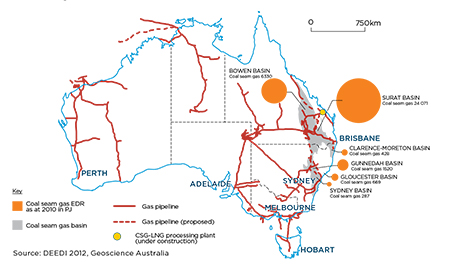I’ve tracked and tried to bring some clarity to the east coast gas debate for 18 months but it’s hard going. The debate is framed in terms of growing supply as the solution to higher prices versus environmental amenity.
But nobody ever discusses anything tangible like where the pipelines run and where more NSW and VIC gas would end up, what the price impacts will be if more gas is extracted, nor what the development implications are for more exports.
The debate transpires purely within ideological boundaries, which is completely idiotic.
The latest offender is the Gary Grey, shadow resources minister, who argues that:
In life we learn from our mistakes. In business it is best for stakeholders, and it is cheaper for investors and shareholders, to learn from the mistakes of others. In government you ignore the mistakes of your predecessors at your peril.
It was an error of judgment by the former NSW administration to endorse a deal between Santos, AGL and landholders, concerning natural gas from coal seams.
…As a consequence, gas owned by the people of NSW may stay in the ground as gas prices go up.
Industry and households need new gas supplies to put downward pressure on gas prices. To extract natural gas from coal seams we need strong, objective and transparent regulations. Landholders need their lawful rights protected, and the environment should be protected.
The people of NSW need a system similar to the one that works in Queensland.
The natural gas sector in Queensland is well positioned to extract gas for the domestic market; and along with it, to create wealth, jobs and community benefits. Queensland is also producing valuable liquefied natural gas for the export market.
This is so poorly argued that the AFR should not have published it. Mr Grey assumes that local prices will fall if QLD’s wild west approach to gas extraction is adopted everywhere, even while admitting that that model has been for export only, which is why gas prices are skyrocketing as the export net back price becomes the default local benchmark. It’s an absurdly self-defeating argument.
The Australian Petroleum and Exploration Assocaition (APPEA) was out yesterday will similar drivel in Victoria. APPEA Chief Operating Officer Eastern Australia, Paul Fennelly said:
APPEA looks forward to taking part in the consultation process and contributing to a fact-based discussion about the safe operation of the industry and its economic potential for Victoria.
“For too long, protracted decision-making processes and planning have brought the state’s onshore gas industry to a standstill.
“Victoria remains the only state in Australia with a moratorium on gas exploration, yet Queensland, for example, is forging ahead with projects worth almost $70 billion that have created 40,000 jobs, most in regional communities.”
Last year’s Victorian Gas Market Taskforce report highlighted the urgent need for onshore gas development:
“Victorians should be under no illusions. Rising gas prices will have a negative impact on Victoria’s manufacturing base. Jobs and investment are at risk. Costs of living will rise and could rise for longer if not addressed.
“The only sensible course of action is for the Victorian Government and other eastern states to promote the production of additional gas supply. Alternative proposals, such as government reservations or subsidies will not address the essence of the issue either in the short or long term.
“The Report concludes that an onshore gas industry cannot only provide economic benefits to farmers, revitalise regional communities and create jobs but at the same time the gas industry can be managed to conserve our environment.”
Gas can currently be piped from Victoria to QLD. There is no existing pipeline from NSW to QLD but it can easily be built and is proposed:

Given the widely accepted shortages of the three LNG plants on Curtis Island, that would mean expanded NSW and VIC supply can very easily end up in North Asia and do nothing for local prices. Moreover, new trains can be built, up north or down south. In the absence of a domestic reservation regime, there is absolutely no guarantee of lower local prices.
And that is before we even examine the break even costs of coal seam gas extraction, which I estimate to be around $7mmbtu. The export net back price is currently around $12 but is going to fall to more like $8 as North America gas pours into the market from 2018. That means the price rises have already largely happened and that coal seam gas is not cheap enough to lower it further anyway.
I’d be ecstatic for anyone to correct me on this stuff if they disagree because, frankly, the public debate is a joke.

